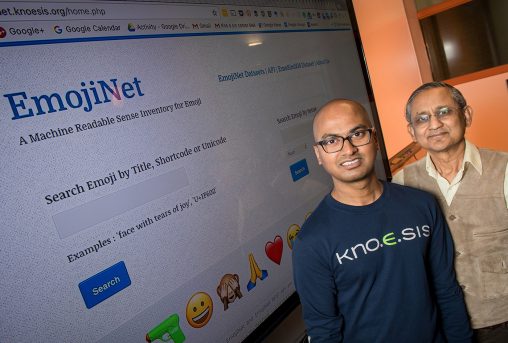
Sanjaya Wijeratne, left, a Ph.D. student in computer science, and Amit Sheth, executive director of Wright State’s Ohio Center of Excellence in Knowledge-Enabled Computing, or Kno.e.sis, EmojiNet, a database of emojis. (Photo by Erin Pence)
There is a smiley face and a frowny face. There are clapping hands, thumbs up and thumbs down. There are hearts and kissy lips. They are emojis — those wildly popular images that have become a language of their own among smartphone users.
And there are a lot of emojis — 2,766 to be exact. Wright State University researchers have created a new database that more precisely defines the meaning of each emoji and promises to improve communication between those who send and receive them. And the database is now being used by the largest group of computer scientists on the planet.
“Kno.e.sis is getting the attention of researchers in the computer science field and leaders in the computer science industry such as Google and Microsoft who are working on building algorithms that can understand and interpret emoji meanings,” said Amit Sheth, who oversees the research effort as LexisNexis Ohio Eminent Scholar and executive director of Wright State’s Ohio Center of Excellence in Knowledge-Enabled Computing, or Kno.e.sis.
Emojis — derived from Japanese “e” for picture and “moji” for character — are pictures of faces, expressions, gestures, animals, sports, food and many other images designed to send a visual electronic message.
Studies have shown that emojis are taking over language used on social media. They have become widely used to enhance the sentiment, emotion and sarcasm expressed in messages, growing in popularity on Facebook, Instagram and Twitter.
The use of emojis increased a whopping 777 percent in 2016 alone. Facebook and Facebook Messenger process over 60 million and 6 billion messages with emojis per day, respectively. In 2015, nearly half of the photo comments posted on Instagram contained emojis.
But emojis can mean different things to different people and to different cultures. And the context in which emojis are used can vary their meaning. For example, a winking-eye emoji can mean approval or that the user’s text message was meant as a joke.
Emojis can also look different depending on the platform in which they are displayed. For example, the same emoji on an iPhone might look different on an Android.
So Sanjaya Wijeratne, a Ph.D. student in computer science at Kno.e.sis, developed EmojiNet, a comprehensive resource for associating meaning with emojis. What dictionaries are to language, EmojiNet is to emojis.
“Emojis have become a new language,” said Sheth. “And they are highly nuanced. There are options for a more precise expression compared to doing a text. And they can be artfully ambiguous.”
The idea for EmojiNet occurred when Wijeratne was working on a project about how street gangs use social media.
“They used emojis in a completely different way than the general population,” he said. “The most popular emoji used by gangs was the gasoline pump because ‘gas’ is a slang term for marijuana. So that’s when we realized that emojis had different meanings based on different contexts.”
Wijeratne and his fellow researchers first went to highly regarded emoji websites and collected keywords emoji users use to describe what they believe to be the meaning of each emoji and how they use it. Those keywords were then automatically linked with online dictionaries such as the multilingual BabelNet that can be read and processed by computers. That database became EmojiNet.
“It’s ultimately up to the community of users as to what the meaning of an emoji is,” said Sheth. “That means you have to rely on a community of people for the keywords.”
EmojiNet can be searched using Emoji names or codepoints. It provides a list of keywords associated with a certain emoji, helps distinguish between similar-looking emojis and shows how a certain emoji looks on different platforms. The database is extremely helpful to computer scientists working on building emoji-related apps and emoji keyboards. And it may help social scientists and psycholinguists to study how different populations use emojis.
“The tool that allows you to pick the emoji requires the kind of thing Sanjaya has developed — EmojiNet,” said Sheth.
Wijeratne said the most challenging thing in trying to identify the real meanings of emojis through keywords was to filter out the “noise.” For example, people who use the “heart” emoji to express love would often use their partner’s name. So those keywords had to be filtered out.
EmojiNet was spotted by the Google company Kaggle, which made it one of its featured datasets, enabling the world’s largest community of computer scientists to use it to solve problems related to the understanding of emojis. EmojiNet has since become among the top 4 percent of the most popular datasets.
EmojiNet was also recently featured in two articles — one in “PsychologyToday.com” written by Marlynn Wei, a Harvard- and Yale-trained psychiatrist, and another by Emoji Foundation, a major resource focused on emoji interpretation and applications.
Wijeratne and Sheh are now working to organize the first international emoji workshop at a premier venue for publishing computer science-related research.

 Bags, boards and bonding
Bags, boards and bonding  More than 1,000 students to graduate at Wright State’s fall commencement ceremonies
More than 1,000 students to graduate at Wright State’s fall commencement ceremonies  Wright State’s Take Flight Program helps students soar high
Wright State’s Take Flight Program helps students soar high  Wright State Police Department delivers major donation to Raider Food Pantry
Wright State Police Department delivers major donation to Raider Food Pantry  Wright State engineering and computer science students earn prestigious federal SMART Scholarships
Wright State engineering and computer science students earn prestigious federal SMART Scholarships 